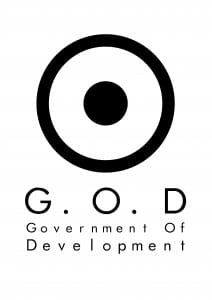Monthly Archives: March 2015
Symbology – Hammerspace
This is a logo/emblem design I had made for Site-Spec last year, with the intention of using it for other stuff too. I refer to it as “Hammerspace”, and whilst I understand if it’s not exactly what you’re all looking for, it’s a good jumping off point. I also have a Illustrator file for it, so it can be resized or tweaked to specification.
For those who don’t know, “hammerspace” is the name that’s used in cartoons and similar media for any pocket dimension from which something is retrieved as if from nowhere, usually hammers, hence the name. When Felix the Cat pulls improbably enormous objects out of his carpet bag, or when Ramona Flowers pulls an oversized mallet from her teeny-tiny purse, they are said to be retrieved from hammerspace. The TARDIS from Doctor Who is similar in terms of its relationship to 3D space, i.e. it is “bigger on the inside” to the point where it is potentially infinite.
Our Father, Forever, Amen.
So while waiting for a dissertation meeting after the class I made this.
Using the religion elements with the cut up technique.
It’s a mash of the lords prayer.
I’m rather proud, and might be a nice spring board for material?
Here it is;
Michel Foucault’s Panopticism
I was doing a little more reading around Foucault’s Panopticism and found this passage which, as I was reading, I started to think sounded like a speech that could be given to the masses. Worth a read, link to full article below.
This enclosed, segmented space, observed at every point, in l which the individuals are inserted in a fixed place, in which the slightest movements are supervised, in which all events are recorded, in which an uninterrupted work of writing links the centre and periphery, in which power is exercised without division, according to a continuous hierarchical figure, in which each individual is constantly located, examined and distributed among the living beings, the sick and the dead – all this constitutes a compact model of the disciplinary mechanism. The plague is met by order; its function is to sort out every possible confusion: that of the disease, which is transmitted when bodies are mixed together; that of the evil, which is increased when fear and death overcome prohibitions. It lays down for each individual his place, his body, his disease and his death, his well-being, by means of an omnipresent and omniscient power that subdivides itself in a regular, uninterrupted way even to the ultimate determination of the individual, of what characterizes him, of what belongs to him, of what happens to him. Against the plague, which is a mixture, discipline brings into play its power, which is one of analysis. A whole literary fiction of the festival grew up around the plague: suspended laws, lifted prohibitions, the frenzy of passing time, bodies mingling together without respect, individuals unmasked, abandoning their statutory identity and the figure under which they had been recognized, allowing a quite different truth to appear. But there was also a political dream of the plague, which was exactly its reverse: not the collective festival, ”but strict divisions; not laws transgressed, but the penetration of regulation into even the smallest details of everyday life through the mediation of the complete hierarchy that assured the capillary functioning of power; not masks that were put on and taken off, but the assignment to each individual of his ‘true’ name, his ‘true’ place, his ‘true’ body, his ‘true’ disease. The plague as a form, at once real and imaginary, of disorder had as its medical and political correlative discipline. Behind the disciplinary mechanisms can be read the haunting memory of ‘contagions’, of the plague, of rebellions, crimes, vagabondage, desertions, people who appear and disappear, live and die in disorder.
http://dm.ncl.ac.uk/courseblog/files/2011/03/michel-foucault-panopticism.pdf
Notebooks and Routines
The nature of these “notebooks” reminds me a lot of what Burroughs would call “routines” – short stories, anecdotal in nature, that acted like “bits”, or scenes that he’d recite like poetry and would become part of his writing. One famous one is his famous “Talking Asshole” routine, set to music below.


